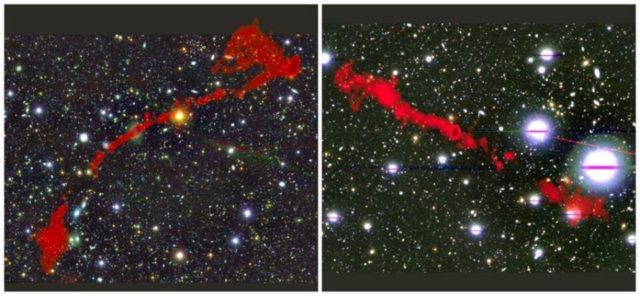The discovery in a small patch of the sky may suggest these scarce giant radio galaxies may be more common than previously thought
RESEARCHERS are floating on cloud nine after two giant radio galaxies were discovered using the MeerKAT telescope that is based in the Northern Cape.
The MeerKAT telescope is located in the Karoo region of the Nortehrn Cape and comprises 64 radio dishes. It was inaugurated in July 2018.
MeerKAT is managed by the South African Radio Astronomy Observatory (SARAO), which is a facility of the National Research Foundation.
In a statement, the University of Cape Town (UCT) said these galaxies are among the largest single objects in the universe and are thought to be quite rare.
The discovery has been published in the Monthly Notices of the Royal Astronomical Society.
It is said the discovery of these galaxies in a small patch of the sky may suggest these scarce giant radio galaxies may be more common than previously thought.
The discovery will give astronomers essential clues about how galaxies have evolved and changed throughout history.
“Many galaxies have supermassive black holes residing in their midst. When large amounts of interstellar gas start to orbit and fall in towards the black hole, the black hole becomes active and huge amounts of energy are released from this region of the galaxy.
“In some active galaxies, charged particles interact with the strong magnetic fields near the black hole and release huge beams, or ‘jets’ of radio light.
“The radio jets of these so-called ‘radio galaxies’ can be many times larger than the galaxy itself and can extend vast distances into intergalactic space,” the university said in the statement.
Research fellow at UCT and lead author of the work Dr Jacinta Delhaize said many hundreds of thousands of radio galaxies have already been discovered, but only 800 of these have radio jets exceeding 700 kilo-parsecs in size or around 22 times the size of the Milky Way, and the truly enormous systems are called giant radio galaxies.
“We found these giant radio galaxies in a region of sky which is only about four times the area of the full moon. Based on our current knowledge of the density of giant radio galaxies in the sky, the probability of finding two of them in this region is extremely small.
“This means that giant radio galaxies are probably far more common than we thought,” Delhaize said.
Research fellow at the University of the Western Cape and co-author Dr Matthew Prescott said these two galaxies are special because they are much bigger than many other radio galaxies.
“They are more than 2 mega-parsecs across, which is around 6.5 million light years or about 62 times the size of the Milky Way. Yet they are fainter than others of the same size.
“We suspect that many more galaxies like these should exist, because of the way we think galaxies should grow and change over their lifetimes,” Prescott said.
The giant radio galaxies were spotted in new radio maps of the sky created by the MeerKAT International Gigahertz Tiered Extragalactic Exploration (MIGHTEE) survey.
It is one of the large survey projects under way with South Africa’s MeerKAT radio telescope and involves a team of astronomers from around the world. Its overall goal is to study the evolution and formation of galaxies.
The sky region in which the two giant galaxies were discovered have been observed before by other radio telescopes from the USA and India but have never been identified.
Co-author at the University of Oxford, Dr Ian Heywood, said the MeerKAT telescope is the best of its kind in the world and that because of MeerKAT they have managed to identify these giant radio galaxies for the first time. This is due to MeerKAT’s unprecedented sensitivity to faint and diffuse radio light.
“This made it possible to detect features that haven’t been seen before. We found large-scale radio jets coming from the central galaxies, as well as fuzzy cloud-like lobes at the ends of the jets.
“We know that these galaxies are several billion light years away, and so it was the discovery of these jets and lobes in the MIGHTEE map that allowed us to confidently identify the objects as giant radio galaxies,” Heywood said.
Delhaize said the existence of the two MIGHTEE giant radio galaxies provide tantalising evidence that a large population of faint, very extended giant radio galaxies may exist.
She said that in the past this population of galaxies had been hidden from sight by the technical limitations of radio telescopes. However, it is now being revealed thanks to the capabilities of new-generation telescopes.
“We hope to uncover more of these giant galaxies in the MIGHTEE survey as it progresses.
“We also expect to find many more with the future Square Kilometre Array (SKA) telescope. The SKA will reveal larger populations of radio galaxies than ever before and revolutionise our understanding of galaxy evolution,” Delhaize added.
Construction of the transcontinental SKA telescope is expected to commence in South Africa and Australia in 2021 and will continue until 2027.
The giant radio galaxies discovered are 2.08 billion light-years and 3.8 billion light-years in distance, respectively.
– African News Agency (ANA)








